Input interpretation

SMILES: BrCl
Basic properties
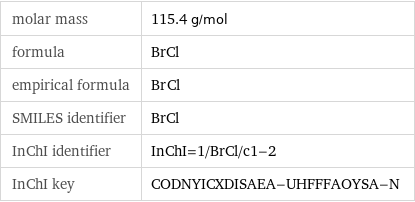
molar mass | 115.4 g/mol formula | BrCl empirical formula | Br_Cl_ SMILES identifier | BrCl InChI identifier | InChI=1/BrCl/c1-2 InChI key | CODNYICXDISAEA-UHFFFAOYSA-N
Lewis structure
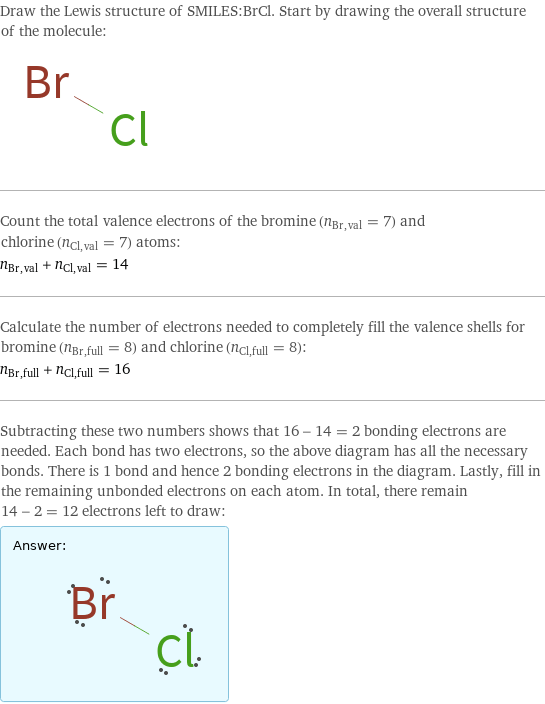
Draw the Lewis structure of SMILES:BrCl. Start by drawing the overall structure of the molecule: Count the total valence electrons of the bromine (n_Br, val = 7) and chlorine (n_Cl, val = 7) atoms: n_Br, val + n_Cl, val = 14 Calculate the number of electrons needed to completely fill the valence shells for bromine (n_Br, full = 8) and chlorine (n_Cl, full = 8): n_Br, full + n_Cl, full = 16 Subtracting these two numbers shows that 16 - 14 = 2 bonding electrons are needed. Each bond has two electrons, so the above diagram has all the necessary bonds. There is 1 bond and hence 2 bonding electrons in the diagram. Lastly, fill in the remaining unbonded electrons on each atom. In total, there remain 14 - 2 = 12 electrons left to draw: Answer: | |
Estimated thermodynamic properties
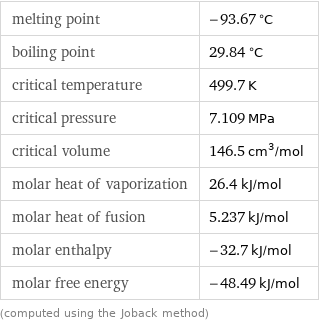
melting point | -93.67 °C boiling point | 29.84 °C critical temperature | 499.7 K critical pressure | 7.109 MPa critical volume | 146.5 cm^3/mol molar heat of vaporization | 26.4 kJ/mol molar heat of fusion | 5.237 kJ/mol molar enthalpy | -32.7 kJ/mol molar free energy | -48.49 kJ/mol (computed using the Joback method)
Units

Quantitative molecular descriptors
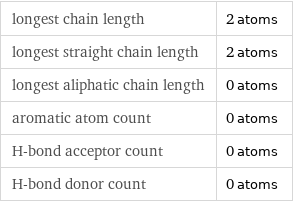
longest chain length | 2 atoms longest straight chain length | 2 atoms longest aliphatic chain length | 0 atoms aromatic atom count | 0 atoms H-bond acceptor count | 0 atoms H-bond donor count | 0 atoms
Elemental composition

Find the elemental composition for SMILES:BrCl in terms of the atom and mass percents: atom percent = N_i/N_total × 100% mass percent = (N_im_i)/m × 100% Plan: • Write the chemical formula and gather atomic masses from the periodic table. • Determine values for N_i, m_i, N_total and m using these items. • Finally, compute the percents and check the results. Write the chemical formula: BrCl Use the chemical formula to count the number of atoms, N_i, for each element and find the total number of atoms, N_total: | number of atoms Br (bromine) | 1 Cl (chlorine) | 1 N_total = 1 + 1 = 2 Divide each N_i by N_total to calculate atom fractions. Then use the property that atom fractions must sum to one to check the work: | number of atoms | atom fraction Br (bromine) | 1 | 1/2 Cl (chlorine) | 1 | 1/2 Check: 1/2 + 1/2 = 1 Compute atom percents using the atom fractions: | number of atoms | atom percent Br (bromine) | 1 | 1/2 × 100% = 50.0% Cl (chlorine) | 1 | 1/2 × 100% = 50.0% Look up the atomic mass, m_i, in unified atomic mass units, u, for each element in the periodic table: | number of atoms | atom percent | atomic mass/u Br (bromine) | 1 | 50.0% | 79.904 Cl (chlorine) | 1 | 50.0% | 35.45 Multiply N_i by m_i to compute the mass for each element. Then sum those values to compute the molecular mass, m: | number of atoms | atom percent | atomic mass/u | mass/u Br (bromine) | 1 | 50.0% | 79.904 | 1 × 79.904 = 79.904 Cl (chlorine) | 1 | 50.0% | 35.45 | 1 × 35.45 = 35.45 m = 79.904 u + 35.45 u = 115.354 u Divide the mass for each element by m to calculate mass fractions. Then use the property that mass fractions must sum to one to check the work: | number of atoms | atom percent | mass fraction Br (bromine) | 1 | 50.0% | 79.904/115.354 Cl (chlorine) | 1 | 50.0% | 35.45/115.354 Check: 79.904/115.354 + 35.45/115.354 = 1 Compute mass percents using the mass fractions: Answer: | | | number of atoms | atom percent | mass percent Br (bromine) | 1 | 50.0% | 79.904/115.354 × 100% = 69.27% Cl (chlorine) | 1 | 50.0% | 35.45/115.354 × 100% = 30.73%
Elemental oxidation states
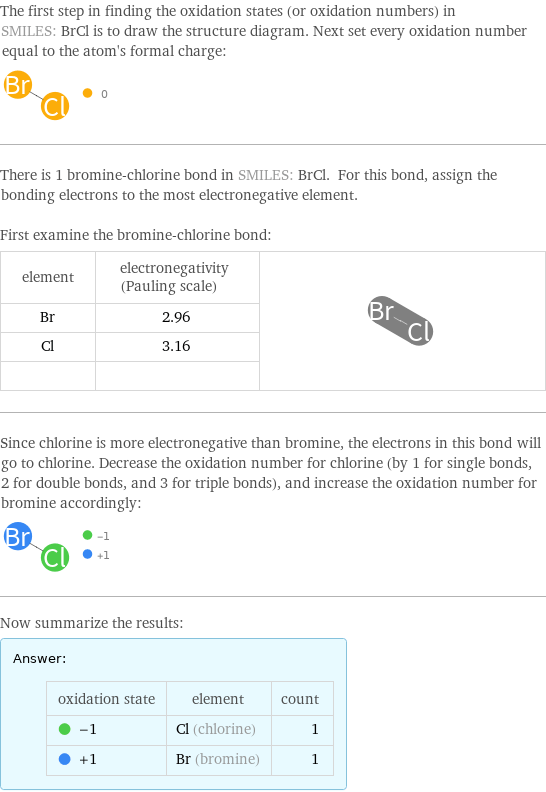
The first step in finding the oxidation states (or oxidation numbers) in SMILES: BrCl is to draw the structure diagram. Next set every oxidation number equal to the atom's formal charge: There is 1 bromine-chlorine bond in SMILES: BrCl. For this bond, assign the bonding electrons to the most electronegative element. First examine the bromine-chlorine bond: element | electronegativity (Pauling scale) | Br | 2.96 | Cl | 3.16 | | | Since chlorine is more electronegative than bromine, the electrons in this bond will go to chlorine. Decrease the oxidation number for chlorine (by 1 for single bonds, 2 for double bonds, and 3 for triple bonds), and increase the oxidation number for bromine accordingly: Now summarize the results: Answer: | | oxidation state | element | count -1 | Cl (chlorine) | 1 +1 | Br (bromine) | 1
Orbital hybridization
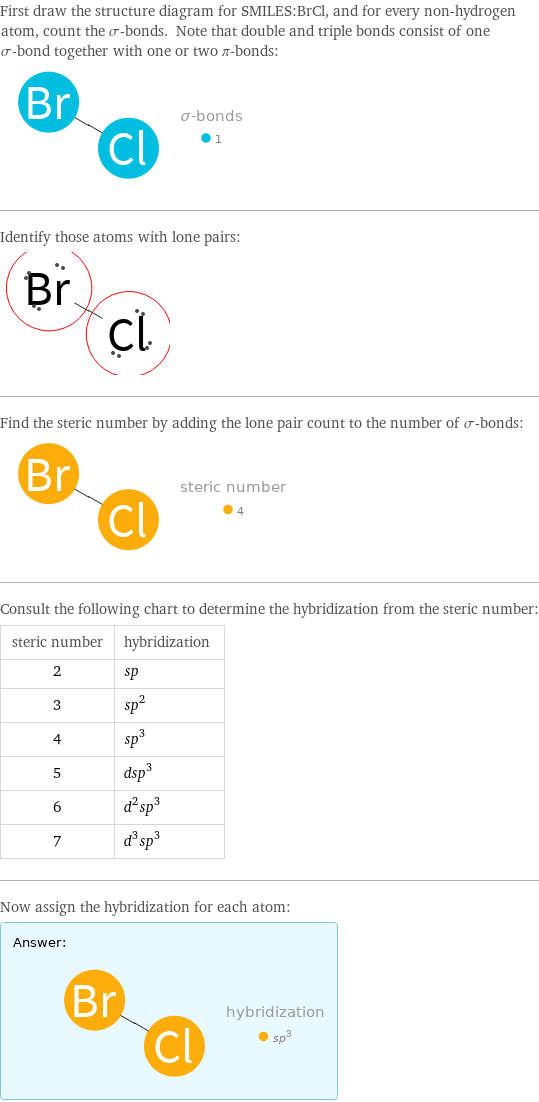
First draw the structure diagram for SMILES:BrCl, and for every non-hydrogen atom, count the σ-bonds. Note that double and triple bonds consist of one σ-bond together with one or two π-bonds: Identify those atoms with lone pairs: Find the steric number by adding the lone pair count to the number of σ-bonds: Consult the following chart to determine the hybridization from the steric number: steric number | hybridization 2 | sp 3 | sp^2 4 | sp^3 5 | dsp^3 6 | d^2sp^3 7 | d^3sp^3 Now assign the hybridization for each atom: Answer: | |
Topological indices
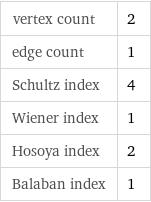
vertex count | 2 edge count | 1 Schultz index | 4 Wiener index | 1 Hosoya index | 2 Balaban index | 1
Isomers

isomer | structure diagram bromine chloride |